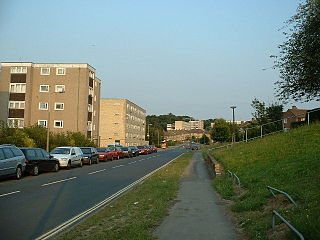Baron Swaythling, of Swaythling in the County of Southampton, is a title in the Peerage of the United Kingdom. It was created in 1907 for the British Jewish Liberal politician, banker and philanthropist, Sir Samuel Montagu, 1st Baronet. He had already been created a Baronet, of South Stoneham House in the County of Southampton and of Kensington Palace Gardens in the County of London, in 1894. As of 2010, the titles are held by his great-great-grandson, the fifth Baron, who succeeded his father in 1998.

Swaythling is a suburb and electoral ward of the city of Southampton in Hampshire, England. The ward has a population of 13,664.

Samuel Montagu, 1st Baron Swaythling, was a British banker who founded the bank of Samuel Montagu & Co. He was a philanthropist and Liberal politician who sat in the House of Commons from 1885 to 1900, and was later raised to the peerage. Montagu was a pious Orthodox Jew, and devoted himself to social services and advancing Jewish institutions.

Portswood is a suburb and Electoral Ward of Southampton, England. The suburb lies to the north-north-east of the city centre and is bounded by Freemantle, Highfield, Swaythling, St. Denys and Bevois Valley.

Townhill Park is a suburb of Southampton, England, bordering Swaythling, Bitterne Park and West End. It is built on land which once belonged to the house which carries the same name.

Swaythling railway station is on the South West Main Line on the northern edge of Southampton in Hampshire, England, serving the area of Swaythling. It is 75 miles 56 chains (121.8 km) down the line from London Waterloo.

Monks Brook is a river in the English county of Hampshire. It is a tributary of the River Itchen, which it joins at a medieval salmon pool in Swaythling. The brook is formed from seven streams that rise in the chalky South Downs, with the official source of Monks Brook being known as Bucket's Corner. Monks Brook drains a clay catchment of 49 square kilometres (19 sq mi). The brook is designated a main river, which means the operating authority for managing it is the Environment Agency, not the local government authorities for the areas through which the river runs.

Bassett is a suburb and electoral ward of the City of Southampton, England. The suburb lies to the north of the city centre and is largely residential, including the University of Southampton's Glen Eyre Halls of residence complex, which houses around 2,100 students. Bassett gives its name to part of the A33 arterial road which links the city centre to the M3, described by Pevsner & Lloyd as "part of the splendid tree-lined route into Southampton from Winchester, London and the north". The highest point in the City of Southampton lies on Bassett Avenue at a height of 82 metres (269 ft) above sea level.

Mansbridge is a suburb on the northern perimeter of Southampton, England. The area is named after the Mans Bridge which spans the River Itchen. For a considerable time, this was the southernmost crossing point of the river, before the construction of Woodmill in Swaythling. The bridge itself still stands and is a Grade II listed structure but is closed to road traffic, having been replaced by a larger and more modern road bridge to carry the A27.

Bassett Green is a suburb of Southampton, which has grown from the original small village of Basset. It remains part of the electoral ward of Bassett. The area is mainly residential, with a mixture of Herbert Collins-designed houses and council built estates known as the Flowers Estate and the Leaside Way Estate. Within Bassett Green are a community centre, Bassett Green Primary School and Southampton Crematorium, as well as several of the University of Southampton's halls of residence.

Herbert Collins (1885–1975) was a British architect, born in Edmonton, London. He designed many of the suburban developments in the city of Southampton in the 1920s and 1930s.

South Stoneham House is a Grade II* listed former manor house in Swaythling, Southampton; the former seat of the Barons Swaythling before the family moved to the nearby Townhill Park House. The building is owned by the University of Southampton, and was used as a hall of residence, part of the Wessex Lane Halls complex.
Louis Samuel Montagu, 2nd Baron Swaythling was a prominent member of the British Jewish community, a financier, and a political activist. He was the son and heir of Samuel Montagu, 1st Baron Swaythling, and of his wife Ellen (Cohen).

Glynllifon is the name of the old estate which belonged to the Barons Newborough, near the village of Llandwrog on the main A499 road between Pwllheli and Caernarfon in Gwynedd, Wales. The original mansion was until recently a privately owned Country House hotel and wedding venue.
South Stoneham was a manor in South Stoneham parish. It was also a hundred, Poor law union, sanitary district then rural district covering a larger area of south Hampshire, England close to Southampton.

St. Mary's Church, South Stoneham is one of the two remaining medieval churches in the city of Southampton, England. Parts of the building date from the Norman period and the chancel arch is 12th century. The church lies in a secluded position off Wessex Lane, near the north-eastern edge of Southampton and is almost hidden in the Southampton University accommodation campus.
Leonard Rome Guthrie was an English architect. He joined the Wimperis & Simpson partnership in 1925 to form Wimperis, Simpson and Guthrie.

Allington is a small settlement in the Borough of Eastleigh, Hampshire, England, located at the northern extremity of the civil parish of West End.
Shamblehurst, also known as Sandhust, was a manor and tithing within the ancient parish of South Stoneham, now in the modern-day Borough of Eastleigh. It had Allington tithing to the north and Botley and Durley parishes to the east.















